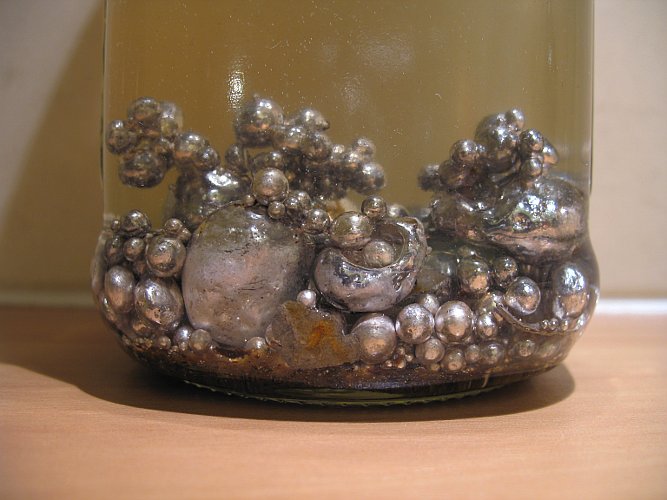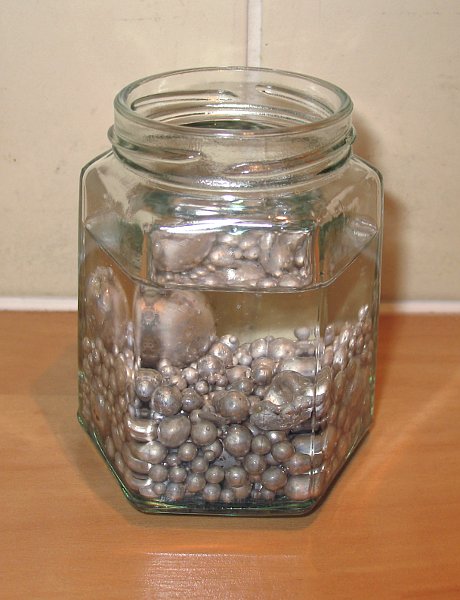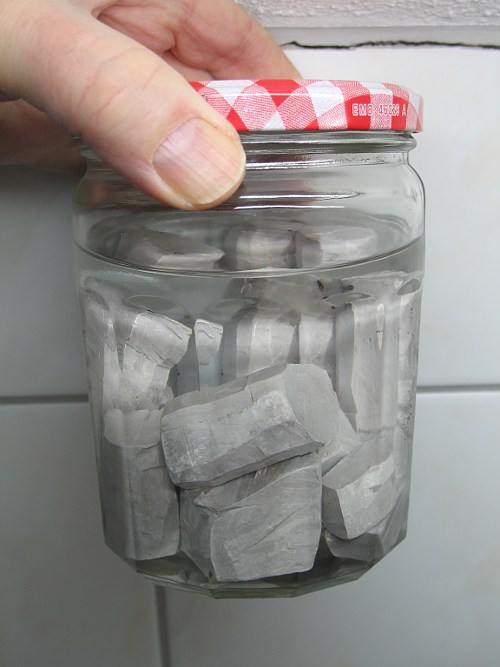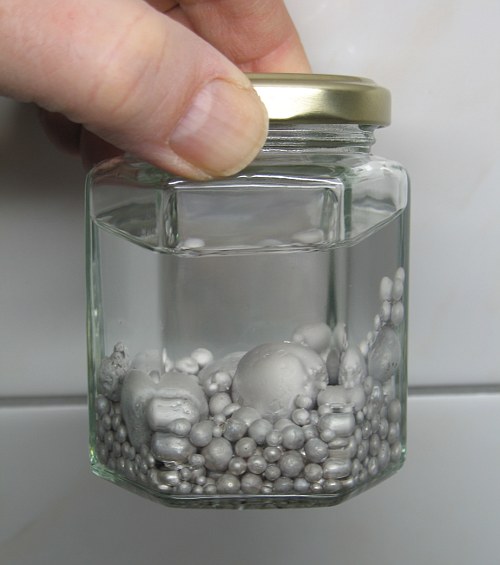woelen
Super Administrator
        
Posts: 8012
Registered: 20-8-2005
Location: Netherlands
Member Is Offline
Mood: interested
|
|
Cleaning sodium metal?
I purchased well over 100 grams of very old sodium metal for just EUR 5, stored under old yellow/brown petroleum (yikes! bad smell). The sodium was
really really dirty, it was covered by a thick crust of brown smelly stuff, most likely from the dirty oil under which it was stored. This brown stuff
certainly is not sodium peroxide nor sodium superoxide.
I peeled all pieces of sodium like a potato with a sharp knife, using latex gloves while doing this, and rinsed the metal with clean high quality
paraffin oil and now I have around 75 grams of nice and clean sodium under colorless pure paraffin oil. It is a pleasure to look at that nice and
clean material 
I still have 25 (maybe even 35) grams of all the waste sodium turnings stored under its brown petroleum. It is a terrible mess. I intended to throw
away this mess, by rinsing it with some volatile petroleum ether and then dumping all sodium at once in a small lake or something like that, but I
think it is a waste of precious sodium metal. After removing the crusts, I'm sure I will have another 20 to 30 grams of sodium.
How could the sodium be cleaned in a safe way? I tried putting some of the turnings in IPA, but this does not really work. It gives a dirty brown mess
and eats away the sodium, but the crust does not really separate. The resulting liquid also is not interesting, it is dirty brown and turbid, not an
interesting solution of sodium isopropylate.
In another experiment I put some of the turnings in a test tube and added some of the petroleum and carefully heated until the sodium melts. When this
is done, many small globules are formed (appr. 4 mm diameter) with still some of the dirty brown stuff attached to the globules. The globules do not
combine to one big ball  If I do this on a larger scale, do you expect the sodium
to combine into a few bigger balls? If I do this on a larger scale, do you expect the sodium
to combine into a few bigger balls?
Any ideas of how to proceed, or should I indeed make one final firework of the sodium by dumping it in the water?
|
|
|
Jor
National Hazard
   
Posts: 950
Registered: 21-11-2007
Member Is Offline
Mood: No Mood
|
|
Why don't you melt the entire batch under parrafin (or xylene as it is done usually, but this is flammable, and I don't like molten alkali metals
under flammables), and try to remove the dirty stuff mechanically, with a pair of tweezers or something like that.
This brown stuff must be some non-volatile hydrocarbon I think. It should dissolve in petroleum ether, of if not try toluene or ether or something
like that? Otherwise, what could the brown mess be? Was the bottle opened already?
|
|
|
woelen
Super Administrator
        
Posts: 8012
Registered: 20-8-2005
Location: Netherlands
Member Is Offline
Mood: interested
|
|
The brown stuff is not soluble in hydrocarbons. The bottle once was opened, but probably not for the last 30 years or so. As stated, the sodium was
stored under yellow/brown petroleum, not under nice clear paraffin oil. The petroleum contains a lot of colored chemicals, it is impure and may
contain sulphur compounds and many other bad stuff (try to imagine how petroleum looked like 50 years ago, this was a not so nice liquid in those
days  , which when burnt gave off a smelly pungent smoke). When this petroleum is
heated, then it smells like I have a leaking USSR-type oil refinery in my backyard , which when burnt gave off a smelly pungent smoke). When this petroleum is
heated, then it smells like I have a leaking USSR-type oil refinery in my backyard 
Mechanical separation is not an option, the dirty brown stuff forms a sticky and flocculent mass around the sodium when it is heated. It becomes hard
and brittle again when it cools down.
|
|
|
mr.crow
National Hazard
   
Posts: 884
Registered: 9-9-2009
Location: Canada
Member Is Offline
Mood: 0xFF
|
|
Have you read Len1's excellent sodium thread? https://www.sciencemadness.org/whisper/viewthread.php?tid=97...
He was successful using parafin oil to clean oxidation and coalesce the globules at high temperature.
Leaking soviet oil refinery, haha!
Double, double toil and trouble; Fire burn, and caldron bubble
|
|
|
woelen
Super Administrator
        
Posts: 8012
Registered: 20-8-2005
Location: Netherlands
Member Is Offline
Mood: interested
|
|
Thanks for the link. I melted my sodium on a heater under the dirty petroleum. It formed many globules, appr. 5 mm in diameter and a few bigger ones.
Unfortunately, I could not heat all the way up to 140 C or so, because the petroleum started boiling well below this temperature, giving off horrible
white smoke and strong smell. Besides that, the brown material started charring. I could, however, get rid of most of the dirty crap. I sieved out the
globules of sodium metal and certainly 95% could be recovered. The smallest globules (some less than 1 mm in diameter) I just dumped, together with
the black charred goo and the brown petroleum. I now have some of the sodium under the remaining petroleum, and I intend to do a second cleanup.
The picture below shows the sodium after this first treatment. The amount of brown and black goo was about the same as the amount of sodium, so I
think that I already have a much better situation  The big globule in the picture
is about 1.5 cm diameter, the medium sized ones are 6 mm in diameter. The big globule in the picture
is about 1.5 cm diameter, the medium sized ones are 6 mm in diameter.

Right now it is very cold (-7 degrees and a lot of wind), so the second phase of cleanup will be when the weather outside is somewhat more pleasant.
[Edited on 8-2-10 by woelen]
|
|
|
woelen
Super Administrator
        
Posts: 8012
Registered: 20-8-2005
Location: Netherlands
Member Is Offline
Mood: interested
|
|
It is quite remarkable what happened here. On standing in the cold, the remaining small amount of crusts on the globules of sodium just cracked off,
leaving perfectly clean sodium behind  . When I saw this, I was pleased very much.
I have taken the jar, as shown in the picture above and have shaken it for some time to help this process a little bit and then allowed to settle
again. And guess what? Very nice shiny globules of sodium can be separated easily from this dirty yellow petroleum and the remaining brown goop. . When I saw this, I was pleased very much.
I have taken the jar, as shown in the picture above and have shaken it for some time to help this process a little bit and then allowed to settle
again. And guess what? Very nice shiny globules of sodium can be separated easily from this dirty yellow petroleum and the remaining brown goop.
I took a little beaker and put in some clean colorless high quality paraffin oil. With a little spoon I collected all sodium from the dirty oil and
transferred it to the clean oil. I swirled this beaker with oil and sodium and then again I transferred the sodium to yet another beaker with fresh
clean paraffin oil and now it is totally clean. Nice and somewhat shiny globules under a layer of perfectly clear and colorless oil. No need to
perform another melt and solidify cycle, as I first intended to do.

I certainly recovered 90% of the waste sodium, probably even more, with just a single pass of heating, like Len1 has done. I have tested a few
globules for purity by putting them in a little water after removal of the adhering oil with a tissue. The sodium melts while frothing around on the
water surface and while doing so, it dissolves giving a solution of NaOH. What remains is a colorless solution. No yellow/brown junk at all.
[Edited on 9-2-10 by woelen]
|
|
|
mr.crow
National Hazard
   
Posts: 884
Registered: 9-9-2009
Location: Canada
Member Is Offline
Mood: 0xFF
|
|
Congrats  Some extra sodium is always nice Some extra sodium is always nice
Double, double toil and trouble; Fire burn, and caldron bubble
|
|
|
chemoleo
Biochemicus Energeticus
    
Posts: 3005
Registered: 23-7-2003
Location: England Germany
Member Is Offline
Mood: crystalline
|
|
So how wil you get the sodium 'bubbles' to coalesce, to fuse? From my experience, that's where the problem resides. On the other hand, the blobs
aren't submillimeter size, so mechanical stirring should help I suppose.
Very nice pics, it lifts my heart seeing this!
Geeks come forth! 
Never Stop to Begin, and Never Begin to Stop...
Tolerance is good. But not with the intolerant! (Wilhelm Busch)
|
|
|
chemrox
International Hazard
    
Posts: 2961
Registered: 18-1-2007
Location: UTM
Member Is Offline
Mood: LaGrangian
|
|
Please do not contaminate a lake with it. There are numerous beings in any pond or lake that are dependent on a stable pH. Melt the shit under inert
atmosphere or motor oil.
"When you let the dumbasses vote you end up with populism followed by autocracy and getting back is a bitch." Plato (sort of)
|
|
|
woelen
Super Administrator
        
Posts: 8012
Registered: 20-8-2005
Location: Netherlands
Member Is Offline
Mood: interested
|
|
@chemoleo: I leave the sodium as it is now, no need to have the spheres coalesce into bigger ones. I do like the small spheres of sodium. They are
around 5 mm diameter and this is quite convenient. If I want to do a little demo experiment (e.g. for the kids), then I just take out a single
'bubble', wipe off the paraffin oil and throw it in some water. For experiments this also is convenient, just take out the number of bubbles you need,
rinse them with petroleum ether to get rid of the oil and then add them to the reaction mixture. No need to cut sodium metal into smaller pieces.
@chemrox: I will not contaminate any lake with the remaining waste. I just put the waste in a plastic bottle which cannot break, and have thrown this
in the trash bin. Waste like this will be burned and then the petroleum and the remaining few sub-mm globules of the sodium, mixed with the brown
goop, simply will be destroyed in the waste-burning oven. This is safe and probably this is environmentally the best thing.
|
|
|
woelen
Super Administrator
        
Posts: 8012
Registered: 20-8-2005
Location: Netherlands
Member Is Offline
Mood: interested
|
|
Now, after two weeks of storage, the sodium has turned a little bit grey. It does not change any further anymore.
This is a picture of the sodium, from which I have cut the dirty brown crust.

And this is the sodium, which I have melted:

As you can see, I have quite a lot of sodium at the moment, altogether it is well over 100 grams of sodium.
[Edited on 21-2-10 by woelen]
|
|
|
mr.crow
National Hazard
   
Posts: 884
Registered: 9-9-2009
Location: Canada
Member Is Offline
Mood: 0xFF
|
|
Ohhh Pretty 
Does your sodium form bubbles like mine does? I think my oil is still contaminated with water.
Double, double toil and trouble; Fire burn, and caldron bubble
|
|
|
The_Davster
A pnictogen
      
Posts: 2861
Registered: 18-11-2003
Member Is Offline
Mood: .
|
|
Bubbles only form if you oil is wet.
A good technique is to treat all new oil with a small amount of sodium for a few days, then when it is dry, use it for storing your sodium.
|
|
|
woelen
Super Administrator
        
Posts: 8012
Registered: 20-8-2005
Location: Netherlands
Member Is Offline
Mood: interested
|
|
I only had bubbles the first day. In the first day, I opened the jars every six hours or so, but after two days no new bubbles formed anymore. Right
now, the storage solution is stable. I have closed these jar very tightly and quite some force is needed to unscrew the caps. These caps are metal
caps with a plastic layer inside and these are closing the jar really well and work exceptionally well for non-corrosive materials. No humidity can
enter these jars.
|
|
|
mr.crow
National Hazard
   
Posts: 884
Registered: 9-9-2009
Location: Canada
Member Is Offline
Mood: 0xFF
|
|
Mine was bubbling for months, but it appears to have stopped now
As an experiment I dropped a piece of gray sodium into 100 degree mineral oil. All the white crap instantly came off leaving it nice and shiny. I took
it off the hotplate before it melted.
This is a good way to clean the metal before using it.
Double, double toil and trouble; Fire burn, and caldron bubble
|
|
|
mr.crow
National Hazard
   
Posts: 884
Registered: 9-9-2009
Location: Canada
Member Is Offline
Mood: 0xFF
|
|
Update: I can see the crystal domains in the sodium, very very nice 
Double, double toil and trouble; Fire burn, and caldron bubble
|
|
|